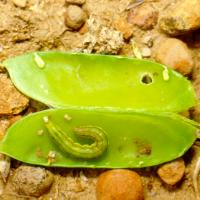Diagnosing native budworm in narrow-leafed lupins
Native budworm caterpillar can cause serious yield loss to lupins as pods mature.
What to look for
- Caterpillars are up to 40mm long, body is shades of orange, brown and green usually with a dark stripe along its body.
Caterpillars feed on leaves and stem until the crop nears maturity when they are attracted to the pods. They drill through the pod wall and eat the seeds.
Pod walls are not penetrated until the caterpillars are over 15mm long.
Insect Larvae
- Damage to narrow leafed lupins only occurs when plants are close to maturity and the pods are losing their green colouration. Look for chewing to leaves, flowers and pods.
Plant
What else could it be
| Condition | Similarities | Differences |
|---|---|---|
| Diagnosing lucerne seed web moth in lupins and peas | Chewed seed in green pods | Lucerne seed moth produce webbing inside the pod and are founnd inside the pod. These caterpillars are small cream to green caterpillar with light red stripes running down the back. |
Where did it come from?
- The native budworm can develop large populations over extensive areas on native plants. These populations often migrate into agricultural regions in late winter and spring. Migratory flights are unpredictable, as moths are carried hundreds of kilometres from breeding areas by high altitude currents.
Management strategies

Spraying insecticide
- The decision to spray can be left until pods are beginning to mature. If caterpillar numbers are below threshold limits, the decision to spray should be delayed and periodic sampling continued. Consider spraying when there are six or more grubs 15mm or longer per 10 sweeps at pod maturation. This threshold varies with grain price and control costs. One well timed spray will control caterpillar populations in most situations.
How can it be monitored?
- Begin monitoring at early pod set using a sweep net. When pods are losing their green colour it is difficult to use a sweep net as the lupin plants are stiff and the pods are spiky. An alternative to sweeping is to cut plants from several places in the crop and shake them into a bin to count caterpillar numbers. Taking a number of plants equal to that found in a square metre, is the easiest method for assessing damage levels for the entire crop.
See also
Page last updated: Monday, 1 May 2017 - 11:40am



